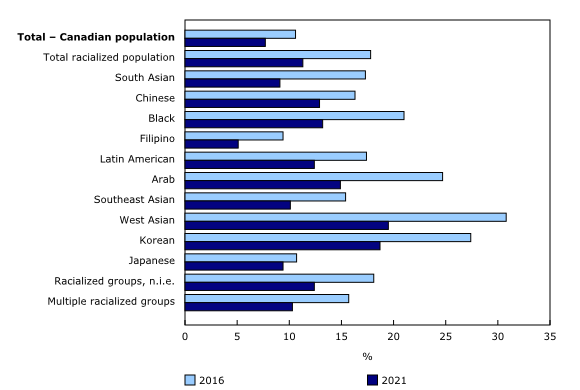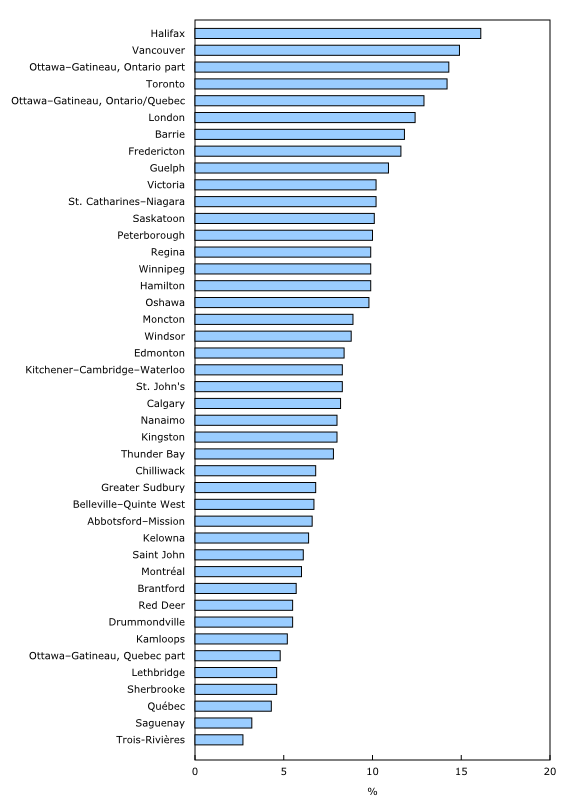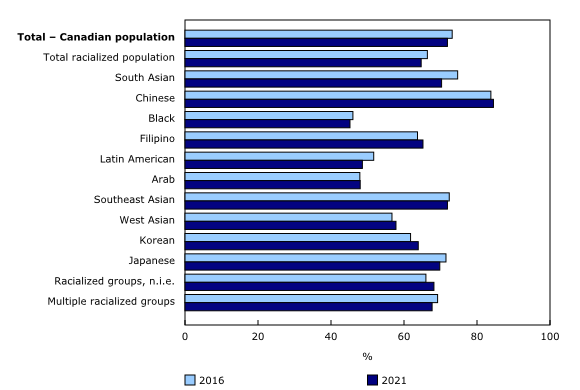Housing conditions among racialized groups: A brief overview
Archived Content
Information identified as archived is provided for reference, research or recordkeeping purposes. It is not subject to the Government of Canada Web Standards and has not been altered or updated since it was archived. Please "contact us" to request a format other than those available.
Released: 2023-01-23
In response to Canada's Anti-Racism Strategy, Statistics Canada's Centre for Gender, Diversity and Inclusion Statistics is releasing a second set of five data tables on social inclusion. Over 20 new indicators, for a total of over 120 indicators, can now be used to examine various socioeconomic facets of racialized Canadians. For more information on the new indicators released today, please see the Note to readers.
Using data from the 2016 and 2021 censuses, this release presents some indicators of the social inclusion of racialized groups under the theme of basic needs and housing, more specifically, the population in core housing need and the population living in a dwelling owned by one or some members of the household.
Living in acceptable housing can play a key role in the satisfaction within a given community and in the social connections in the neighbourhood. Housing is also an anchor that offers security and access to local and essential services, such as transportation, education services, public facilities and green space for leisure.
For these reasons, housing characteristics, such as core housing need and home ownership, are indicators of social inclusion relevant to developing anti-racism and anti-discrimination policies that aim to improve inclusivity.
The proportion of racialized Canadians in core housing need is on the decline
The COVID-19 pandemic shook the housing and rental market and, in many ways, redefined the needs for and functions of housing in the world of work, education and health. For some population groups, including racialized groups, finding adequate and suitable housing that is within their budget and meets their space requirements may have been particularly challenging.
The term "core housing need" refers to a household whose dwelling does not meet the threshold of at least one of the housing adequacy, affordability or suitability indicators and that would have to spend at least 30% of its total before-tax income on the median rent of another acceptable dwelling. For more information on the measure of each indicator, see Core housing need in the Dictionary, Census of Population, 2021.
Living in core housing need can have a negative impact on a variety of aspects. For example, unaffordable housing can constrain a household's financial capacity to cover other essential expenses, such as groceries, transportation and clothing, especially for those with lower incomes. Poor housing conditions, such as the need for major repairs and overcrowding (i.e., unsuitable dwelling), can increase the risk of infectious or chronic diseases and injuries and affect children's development and educational attainment.
In 2021, 11.3% of racialized Canadians lived in a household in core housing need, a decrease of 6.5 percentage points from the 2016 Census.
However, these proportions were higher than those observed in the total population in both the 2016 and 2021 censuses.
Among racialized groups, West Asian, Korean and Arab populations have the highest proportions of people in core housing need
Among racialized groups, West Asian (19.5%), Korean (18.7%) and Arab (14.9%) Canadians were the most likely to be in core housing need, while Filipino (5.1%), South Asian (9.1%) and Japanese (9.4%) Canadians posted the lowest proportions.
Just as the overall trend, the percentage of each racialized group in core housing need saw a decline from 2016 to 2021. West Asian, Arab, Korean, South Asian and Black Canadians reported the largest declines in percentage points.
These results can be explained in large part by the temporary pandemic income supports, especially for people with lower income. In 2016, the West Asian, Korean and Black racialized groups were among those that posted the lowest average employment income and average weekly earnings of full-time employees. The additional source of income during the pandemic reduced the share of income dedicated to housing cost and contributed to improved housing conditions by allowing some people to live in more affordable housing.
Racialized Canadians who came to Canada as immigrants are more likely to be in core housing need than their non-immigrant counterparts
One of the factors behind the prevalence of living in core housing need is related to the socioeconomic situation that can be transitory for certain population groups, such as those who were born outside Canada and recently arrived through the immigration process.
Overall, and for most racialized groups, core housing need was higher among individuals who were members of racialized groups and were also immigrants (11.4%) than among their non-immigrant counterparts (9.8%).
In terms of the period of immigration, the gap was larger between immigrants who have established in Canada in the past 10 years (13.2%), from 2011 to 2021, and immigrants who came to the country more than 10 years ago (10.5%).
The Arab, Chinese and West Asian Canadians who have established in Canada in the past 10 years were among the racialized groups that posted the largest differences in percentage points compared with their counterparts who have been in the country for more than 10 years.
Among racialized Canadians who settled in Canada in the past 10 years, West Asian (22.3%), Arab (21.5%) and Chinese (19.4%) people were also among the groups that were most likely to be in core housing need.
The prevalence of living in core housing need is lower in urban centres of Quebec
The housing conditions of racialized groups varied by census metropolitan area (CMA).
In 2021, among the 10 CMAs with the highest proportion of the racialized population in core housing need, 6 were in Ontario: Ottawa–Gatineau (Ontario part) (14.3%), Toronto (14.2%), London (12.4%), Barrie (11.8%), Guelph (10.9%) and St. Catharines–Niagara (10.2%). Conversely, 6 of the 10 CMAs with the lowest proportion of the racialized population living in core housing need were in Quebec. The proportions ranged from 5.5% (Drummondville) to 2.7% (Trois-Rivières).
Among racialized groups, Chinese, South Asian and Southeast Asian populations are most likely to live in owner household
In addition to being an investment, home ownership may provide stability and indicate a long-term settlement in a given community. However, it can also constitute a larger financial burden. The 2021 Census results on housing show a decline in the proportion of Canadian households that own their home.
While the racialized population is no exception to this general trend, some groups have remained more likely over time to live in a dwelling owned by one or some members of the household.
In 2021, among racialized groups, Chinese (84.5%), Southeast Asian (71.9%) and South Asian (70.3%) populations had the highest proportions of home ownership.
In contrast, the Black (45.2%), Arab (48.0%) and Latin American (48.6%) populations were least likely to live in a dwelling owned by one or some members of the household. For the total Canadian population, the proportion was 71.9% in 2021.
Looking ahead
The indicators published today complement those currently available in the Gender, Diversity and Inclusion Statistics Hub. They are part of a broader conceptual framework that covers a total of 11 themes for the analysis of the social inclusion of racialized groups. These themes are participation in the labour market, representation in decision-making positions, civic engagement and political participation, basic needs and housing, health and well-being, education and skills development, income and wealth, social connections and personal networks, local community, public services and institutions, and discrimination and victimization.
Statistics Canada will continue to update the indicators using the latest available data. The currently available tables are based on the 2006 and the 2016 censuses, 2011 National Household Survey, 2021 Canadian Housing Survey, 2021 Uniform Crime Reporting Survey, 2020 Canadian Community Health Survey, 2020 General Social Survey – Social Identity and 2019 General Social Survey – Victimization.
Note to readers
The concept of "racialized population" is measured with the "visible minority" variable in this release. Visible minority refers to whether a person is a visible minority or not, as defined by the Employment Equity Act. The Employment Equity Act defines visible minorities as "persons, other than Aboriginal peoples, who are non-Caucasian in race or non-white in colour." The visible minority population consists mainly of the following groups: South Asian, Chinese, Black, Filipino, Arab, Latin American, Southeast Asian, West Asian, Korean and Japanese. In 2021 Census analytical and communications products, the term "visible minority" has been replaced by the terms "racialized population" or "racialized groups," reflecting the increased use of these terms in the public sphere.
Immigrant refers to a person who is or has been a landed immigrant or permanent resident. Such a person has been granted the right to live in Canada permanently by immigration authorities. Immigrants who have obtained Canadian citizenship by naturalization are included in this group.
Period of immigration refers to the period in which the immigrant first obtained landed immigrant or permanent resident status. The "period of immigration" variable is used to identify recent immigrants. The term "recent immigrant" refers to a person who obtained landed immigrant or permanent resident status up to five years prior to a given census year. In the 2021 Census, this period is January 1, 2016, to May 11, 2021.
Non-permanent residents are included in the "Total – racialized population" but are not displayed in this article. The data and results associated with this population are available in the tables published today, as well as the other tables on social inclusion indicators using census data.
Non-permanent resident refers to a person from another country with a usual place of residence in Canada and who has a work or study permit or who has claimed refugee status (asylum claimant). Family members living with work or study permit holders are also included, unless these family members are already Canadian citizens, landed immigrants or permanent residents.
Contact information
For more information, or to enquire about the concepts, methods or data quality of this release, contact us (toll-free 1-800-263-1136; 514-283-8300; infostats@statcan.gc.ca) or Media Relations (statcan.mediahotline-ligneinfomedias.statcan@statcan.gc.ca).
- Date modified:




